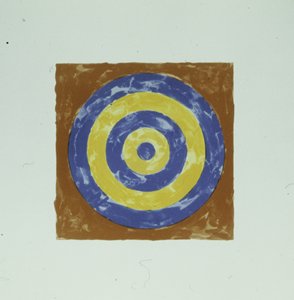This weekend is the annual Twin Cities Pride Festival in Minneapolis, the first since same-sex marriage became legal in Minnesota—a goal scarcely on the radar when the festival began as a gay-rights protest in 1972.
The majority of works in the MIA collection by gay artists or capturing gay life have not been acknowledged in such terms (St. Sebastian, David—they’re just beautiful men, right?). Yet many, even at at the time of their creation, were understood in that context by those in the know. Here, four images that trace this history through the collection.
1. Tom Arndt’s Gay Pride Rally, Minneapolis, 1981
 Even drag queens had perms in the ’80s. We don’t know who these lovely ladies are. If you do, let us know.
Even drag queens had perms in the ’80s. We don’t know who these lovely ladies are. If you do, let us know.
2. Jasper Johns’s Target from 1967
 Jasper Johns and Robert Rauschenberg, whose playful and pointed work managed to soften the machismo associated with the abstract expressionism of post-war art, were lovers for six years, though they never publicly put it in those terms. “Affectionately involved” is how Rauschenberg described it in an interview in which he also says they split up because they were embarrassed. “What had been tender and sensitive became gossip,” he said. “It was sort of new to the art world that the two most well-known, up-and-coming studs were affectionately involved.”
Jasper Johns and Robert Rauschenberg, whose playful and pointed work managed to soften the machismo associated with the abstract expressionism of post-war art, were lovers for six years, though they never publicly put it in those terms. “Affectionately involved” is how Rauschenberg described it in an interview in which he also says they split up because they were embarrassed. “What had been tender and sensitive became gossip,” he said. “It was sort of new to the art world that the two most well-known, up-and-coming studs were affectionately involved.”
3. Paul Cadmus’s YMCA Locker Room from 1934
 Cadmus didn’t skirt controversy, even when he was painting under the auspices of the WPA during the Great Depression. He painted a kind of realism—a “literary painter,” he called himself. His famous The Fleet’s In shows carousing sailors in New York, including a homosexual pickup. The painting was pulled from a show by an outraged Navy official. This image was an earlier work, a mock-classical tableaux of what would become his signature imagery: men bursting out of their clothes, if indeed they’re wearing any.
Cadmus didn’t skirt controversy, even when he was painting under the auspices of the WPA during the Great Depression. He painted a kind of realism—a “literary painter,” he called himself. His famous The Fleet’s In shows carousing sailors in New York, including a homosexual pickup. The painting was pulled from a show by an outraged Navy official. This image was an earlier work, a mock-classical tableaux of what would become his signature imagery: men bursting out of their clothes, if indeed they’re wearing any.
4. F. Holland Day’s Ebony and Ivory from 1897
 Day was gay, that much may be obvious—though it wasn’t so obvious in the context of the neoclassical imagery he created, which gave him a reputation as the first American photographer to treat photography as an art form. Described as a “wealthy and eccentric aesthete,” he photographed gay activists and half-dressed models—often non-white “primitives” who just happened to not wear many clothes—and counted some powerful gay men among his patrons.
Day was gay, that much may be obvious—though it wasn’t so obvious in the context of the neoclassical imagery he created, which gave him a reputation as the first American photographer to treat photography as an art form. Described as a “wealthy and eccentric aesthete,” he photographed gay activists and half-dressed models—often non-white “primitives” who just happened to not wear many clothes—and counted some powerful gay men among his patrons.
Lead image: Robert Mapplethorpe’s Thomas, currently on display in the Harrison Photography Gallery at the MIA.

